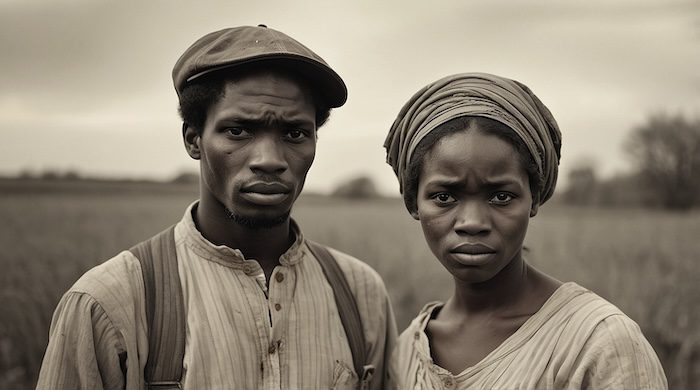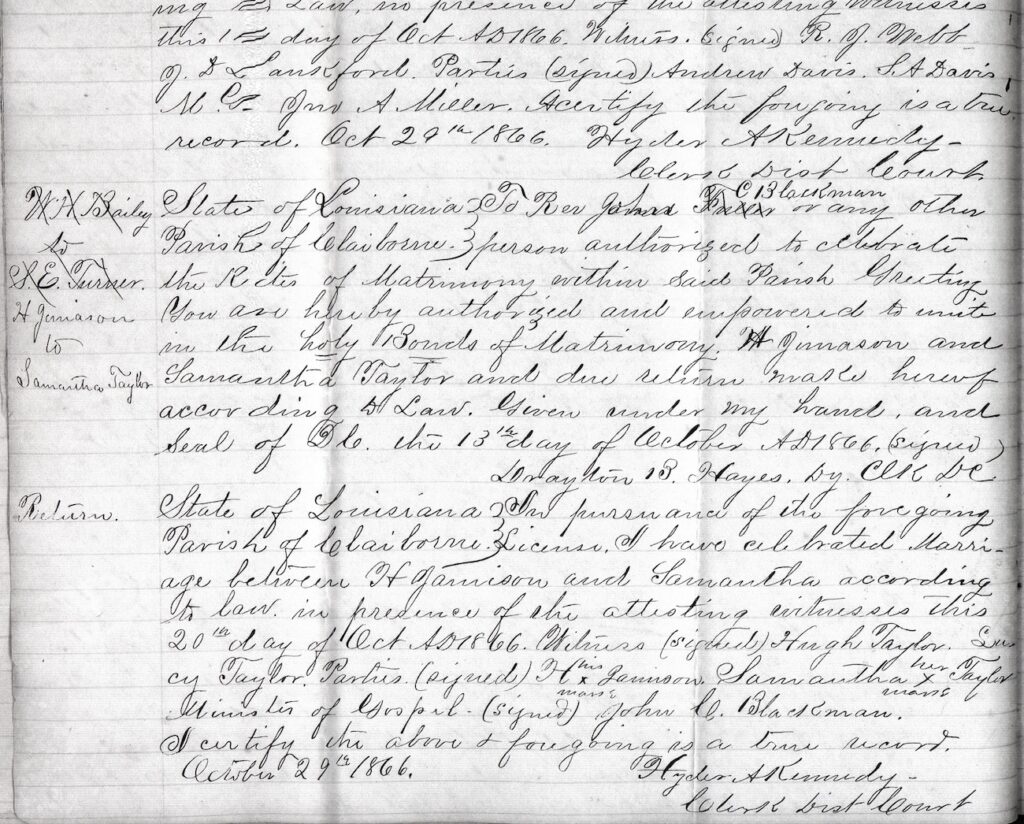Cohabitation Records
- Ancestry.com
- FamilySearch
- Library of Virginia
- National Archives
Cohabitation Records are documents that list couples—often formerly enslaved—who were living together as husband and wife during slavery. After the Civil War, states and Freedmen’s Bureau offices began recording these unions to provide legal recognition and legitimacy to marriages that had previously been denied under slavery.
These records serve as valuable tools for genealogical research, as they provide names, relationships, and dates that are often missing from other official documents. For descendants, they represent one of the first formal acknowledgments of African American family life in the historical record.
Explore Freedmen’s Bureau Cohabitation Records
“Hover over a county or parish to see its name, Microfilm Publication, and a description of the records available. Each county/parish contains one or more markers showing the locations of Freedmen’s Bureau field offices. Click a marker to open that office’s records page, where you’ll find links, context, and research tips. You can also use the Select: dropdown menu above the map to jump directly to a county or parish.”
Freedmen's Bureau Marriages, 1859-1873
- Freedmen’s Bureau Field Offices (placed by State / County)
- Freedmen’s Bureau Field Offices (placed by State / County)
Historical Context: Legalizing Marriage After Slavery
Before emancipation, enslaved people were denied legal personhood. Marriage was not recognized because they were considered property. This changed during the Civil War and Reconstruction when state legislatures and the Freedmen’s Bureau authorized recognition of enslaved marriages.
- ➡️ Legalization of Marriage: Each Southern state passed laws at different times (1865–1867) to legalize cohabiting unions.
- ➡️ Freedmen’s Bureau Records: Bureau agents often recorded these marriages, creating registers that survive today.
- ➡️ Community Significance: Recognition protect
Renate Yarborough Sanders and Taneya Koonce
Marriage - State Laws
These records were created by the Bureau’s local field offices and provide detailed insights into the lives of formerly enslaved individuals, free African Americans, and impoverished white Southerners. 1865-1872
Section 1: Be it ordained by the people of the State of Alabama in convention assembled, That all marriages between freedmen and freedwomen, whether in a state of slavery or since their emancipation, heretofore solemnized by any one acting or officiating as a minister, or any one claiming to exercise the right to solemnize the rites of matrimony, whether bond or free, are hereby ratified and made valid, provided the parties are now living together as man and wife; and in all cases of freedmen and freedwomen who are now living together recognizing each other as man and wife, be it ordained that the same are hereby declared to be man and wife, and bound by the legal obligation of such relationship
Law (Reconstruction): Arkansas passed “An Act to Legalize Marriages of Persons of Color” on Dec 20, 1866, validating marriages of African Americans cohabiting as husband and wife; a follow-on act (Feb 6, 1867) legitimated children born before formal ceremony. Cambridge University Press & Assessment
Where the records are: Bureau-era marriage certificates for Arkansas appear in the NARA RG 105 headquarters set (M1875) and in FamilySearch’s “United States, Freedmen’s Bureau Marriages” collection. For broader Arkansas field office context (what survives where), see the NARA guide to Records of the Field Offices for Arkansas.
Law / practice: Delaware didn’t enact a special “cohabitation” statute like some Southern states; after the 13th Amendment and federal civil-rights measures, marriages of Black couples proceeded under state civil law (note Delaware kept an anti-miscegenation ban until Loving; see below). For Bureau assistance, Delaware was administered with Maryland; clerks’ refusals were sometimes handled via Bureau processes or by recording at D.C. headquarters. National Archives
Where the records are: Freedmen’s Bureau field office records for Maryland & Delaware (M1906) and the centralized M1875 marriage files; Delaware state marriage certificates are held by Delaware Public Archives (modern issuance up to 1970). National Archives, FamilySearch
Law / practice: Delaware didn’t enact a special “cohabitation” statute like some Southern states; after the 13th Amendment and federal civil-rights measures, marriages of Black couples proceeded under state civil law (note Delaware kept an anti-miscegenation ban until Loving; see below). For Bureau assistance, Delaware was administered with Maryland; clerks’ refusals were sometimes handled via Bureau processes or by recording at D.C. headquarters. National Archives
Where the records are: Freedmen’s Bureau field office records for Maryland & Delaware (M1906) and the centralized M1875 marriage files; Delaware state marriage certificates are held by Delaware Public Archives (modern issuance up to 1970). National Archives, FamilySearch
Law (state): “An Act to Establish and Enforce the Marriage Relation between Persons of Color,” Jan 11, 1866—Black couples were given a fixed period (nine months) to register past unions, thereby legalizing/legitimating them under Florida law. STARS_STARS
Where the records are: Florida marriages are included in NARA M1875 and in FamilySearch’s Freedmen’s Bureau Marriages database. National Archives
(No. 252) An Act to prescribe and regulate the relation of Husband and Wife between persons of color. 5. Sec. 1. The General Assembly of the State of Georgia do enact:
That persons of color, now living together as husband and wife, are hereby declared to sustain that legal relation to each other, unless a man shall have two or more reputed wives, or a woman two or more reputed husbands. In such event, the man, immediately after the passage of this Act by the General assembly, shall select one of his reputed wives, with her consent; or the woman one of her reputed husbands, with his consent; and the ceremony of marriage between these two shall be performed.
If such man, thus living with more than one woman, or such woman living with more than one man, shall fail or refuse, to comply with the provisions of this section, he or she shall be prosecuted for the offence of fornication, or adultery, or fornication and adultery, and punished accordingly
Law (state context): Illinois was a free state (no Bureau field structure like the South), but it banned interracial marriage by statute in 1829; the ban was repealed in 1874. Black couples could marry under civil law; interracial couples could not until repeal. Chicago Public Library+1
Where the records are: Use county clerk civil marriage registers (pre-1900) and Illinois archives/library guides. Note: Illinois is not represented in NARA’s M1875 Bureau marriage set. Illinois Secretary of State
Kentucky’s statute (approved February 14, 1866)
Legalized marriages between African Americans: “all negroes and mulattos may intermarry with each other in the same manner and under the same regulations” as whites; clerks were to keep separate marriage records for Black and white couples. Couples already living together could appear before the county court clerk, pay 50¢ to record their declaration, and for an extra 25¢ receive a certificate. Children of these unions were declared legitimate. Legislative Research Commission
The same 1866 package prohibited interracial marriage (miscegenation) with felony penalties under Kentucky law.
Law (state + Bureau practice): During Reconstruction, Louisiana repealed its interracial marriage ban in 1868 (it was later reinstated in 1894). The Bureau actively recorded marriages in Louisiana subdistricts (e.g., Bragg Home Colony, Donaldsonville, Mansfield, Shreveport, 1865–1866). EJI Calendar
Where the records are: Louisiana entries appear in NARA M1875 and in the FamilySearch Freedmen’s Bureau Marriages collection; the Prologue overview lists example subdistrict registers. National Archives, FamilySearch
Sec. 3 Be it further enacted, that all freedmen, free negroes and mulattoes, who do now and have heretofore lived and cohabited together as husband and wife shall be taken and held in law as legally married, and the issue shall be taken and held as legitimate for all purposes.
Law / practice: Missouri abolished slavery Jan 11, 1865, retained an anti-miscegenation law (not repealed until 1969). Many counties created “Negro and Colored Marriage” books that retrospectively recorded slave-era unions—often prompted by Bureau guidance. shsmo.org
Where the records are: Missouri State Archives guides note these colored marriage registers; Bureau microfilm for MO exists at the state archives, and Bureau marriages touching Missouri appear in M1875 / FamilySearch where applicable. Missouri Secretary of State, National Archives
In the March 1866 session of the North Carolina General Assembly, an Act was passed concerning negroes and persons of color. Justices of the Peace were to collect and record in the County Clerk’s office, a record of the cohabitation of former slaves to ratify their state of marriage.
The Court Clerk was required to maintain a record book for this purpose and to receive 25 cents per entry for his service. In Section 6, Chapter 40 of the Act, it was a misdemeanor if negroes did not record their marriage by September, 1866. This section of the Act was amended by Section 1, Chapter 70 (ratified March 1867), to extend the time of recording these marriages until January 1, 1868.
Sec, 5 . . . all free persons of color who were living together as husband and wife in this state, while in a state of slavery, are hereby declared to be man and wife, and their children legitimately entitled to an inheritance in any property heretofore acquired, or that my hereafter be acquired by said parents.
The Cohabitation Records, offically titled, "Register of Colored Persons, Augusta County, State of Virginia, Cohabiting Together as Husband and Wife," are a record of free African American families living in Virginia immediately after the end of the Civil War. The records were created by the Freedmen's Bureau in an effort to document the marriages of formerly enslaved men and women that were legally recognized by an act of the Virginia Assembly in February 1866.



